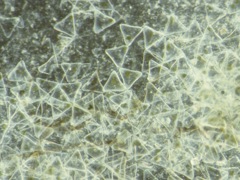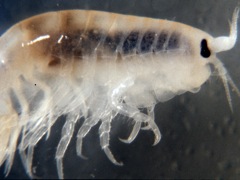The marine ecosystem of the Beaufort Sea is a relatively simple yet highly interconnected environment. From tiny organisms known as phytoplankton to the belugas and humans at the other end of the food chain, each species is highly dependent on the others for nourishment and sustenance. Learn about the food web in the Beaufort Sea below:
Phytoplankton
Tiny marine organisms known as phytoplankton form the basis of the arctic food web.
Phytoplankton obtain energy through the process of photosynthesis and must therefore live in the well-lit surface layer (called the euphotic zone) of the ocean. Phytoplankton account for half of all photosynthetic activity on Earth. Phytoplankton are therefore responsible for much of the oxygen present in the Earth's atmosphere – half of the total amount produced by all plant life.
Sea worms and arctic cod feed on the phytoplankton.
Sea Worms
Small sea worms feed on phytoplankton.
There are approximately 470 species of sea worms in the Arctic, and they are very diverse in their lifestyles, body shapes and colors.
Sea worms found in the Arctic are typically very small. Many measure only a few millimetres in length and most are less than ten centimetres.
Sea worms are in turn eaten by amphipods (shrimp-like crustaceans).
Shrimp
Amphipods (small, shrimp-like crustaceans) may feed on sea worms, but they are also considered detritivores, meaning they consume decomposing organic matter. The name amphipoda means "different-footed."
Amphipods are typically less than 10 millimetres in length.
They are the significant source of food for arctic cod.
Arctic Cod
Arctic cod (Arctogadus glacialis) are plentiful in the regions inhabited by beluga whales and are an important source of nutrition for the beluga. Belugas may consume approximately 1000 arctic cod per day.
Arctic cod can be found at depths of up to 1000 metres. They can grow up to 30 centimetres in length, though they are usually much smaller than that. They feed primarily on plankton, sea worms and shrimp.
The arctic cod favours temperatures below 4°C and it is one of the few fish that thrives in temperatures below 0°C. Antifreeze proteins in its blood are one adaptation responsible for this ability.



